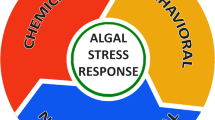Abstract
The marine Vibrio DW1 exhibited a positive response in heat output to a dialysis membrane surface in the presence of substrate (100 mM sodium glutamate) and, more particularly, in the absence of exogenous substrate (starvation conditions). The latter result paralleled the previously reported decrease in cell volume and increase in oxygen consumption by starving bacteria at a similar surface. Modified Morita's salts (MMS) did not extract nutrients from the dialysis membrane, but an artificial seawater containing tris buffer (ASW-tris) did extract surface active and nutrient materials from the membrane. The ASW-tris membrane extract and a commercial surfactant, Tween 85, were found to mimic the effects of the dialysis membrane surface by inducing a decrease in cell volume, and an increasing oxygen consumption and heat output of Vibrio DW1 even in the bulk liquid. The significance of the adsorption of naturally occurring surfactants at surfaces in relation to the behaviour of bacteria at the surfaces is discussed.
Similar content being viewed by others
Abbreviations
- ASW:
-
artificial seawater
- MMS:
-
modified Morita's salts
- NMMS:
-
nutrient modified Morita's salts
- MMSG:
-
MMS plus 100 mM sodium glutamate
References
Anwar H, Brown MRW, Britten AZ, Lambert PA (1983) Disruptive effects of tris and sodium lauroyl sarcosinate on the outer membrane of Pseudomonas cepacia by fluorescent probes. J Gen Microbiol 129:2017–2020
Bright JJ, Fletcher M (1983) Amino acid assimilation and electron transport system activity in attached and free-living marine bacteria. Appl Environ Microbiol 45:818–825
Dawson MP, Humphrey BA, Marshall KC (1981) Adhesion: a tactic in the survival strategy of a marine vibrio during starvation. Curr Microbiol 6:195–199
Gordon AS, Gerchakov SM, Millero J (1983) Effects of inorganic particles on metabolism by a periphytic marine bacterium. Appl Environ Microbiol 45:411–417
Humphrey BA, Kjelleberg S, Marshall KC (1982) Responses of marine bacteria under starvation conditions at a solid-water interface. Appl Environ Microbiol 45:43–47
Kefford B, Kjelleberg S, Marshall KC (1982) Bacterial scavenging: utilization of fatty acids localized at a solid-liquid interface. Arch Microbiol 133:257–260
Kirchman D, Mitchell R (1982) Contribution of particle-bound bacteria to total microheterotrophic activity in five ponds and two marshes. Appl Environ Microbiol 43:200–209
Kjelleberg S, Humphrey BA, Marshall KC (1982) Effect of interfaces on small, starved marine bacteria. Appl Environ Microbiol 43:1166–1172
Kjelleberg S, Humphrey BA, Marshall KC (1983) Initial phases of starvation and activity of bacteria at surfaces. Appl Environ Microbiol 46:978–984
Lupton FS, Marshall KC (1979) Effectiveness of surfactants in the microbial degradation of oil. Geomicrobiol J 1:235–247
Marshall KC, Stout R, Mitchell R (1971) Mechanism of the initial events in the sorption of marine bacteria to surfaces. J Gen Microbiol 68:337–348
Novitsky JA, Morita RY (1978) Possible strategy for the survival of marine bacteria under starvation conditions. Mar Biol 48:289–295
Author information
Authors and Affiliations
Rights and permissions
About this article
Cite this article
Humphrey, B.A., Marshall, K.C. The triggering effect of surfaces and surfactants on heat output, oxygen consumption and size reduction of a starving marine Vibrio . Arch. Microbiol. 140, 166–170 (1984). https://doi.org/10.1007/BF00454920
Received:
Accepted:
Issue Date:
DOI: https://doi.org/10.1007/BF00454920




